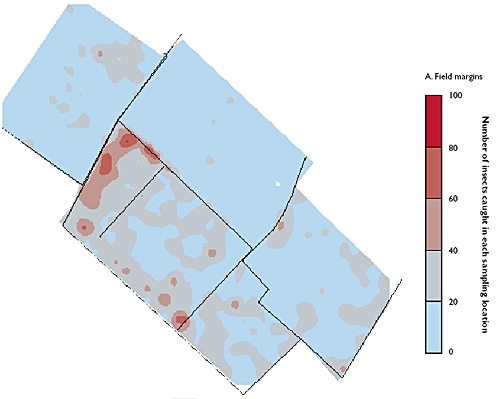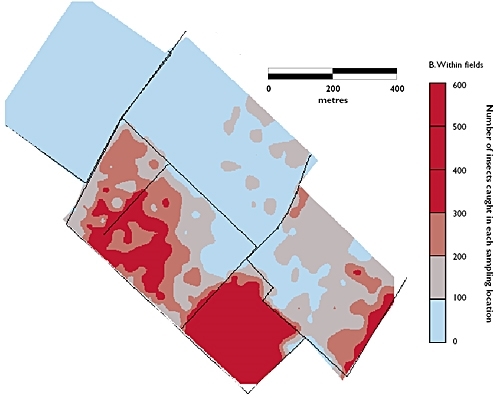The overall aim of the '3D' project was to develop management strategies for enhancing natural control of aphid pests in field crops, allowing farmers to fulfil their environmental commitments without jeopardising profitable crop production. This was achieved by looking at the '3Ds': invertebrate Density, Diversity and Distribution. Our research partners, Rothamsted Research, Central Science Laboratory and Scottish Agricultural Colleges, examined whether aphid control could be increased by parasitic wasps manipulated using aphid pheromones, and by hoverflies, encouraged using flower-rich margins.
In our research we studied the distribution of ground-active insects, weeds and soil moisture across six fields, over three years, using a grid of 973 sampling locations. After the first year, we established 20-metre wide set-aside strips sown with wild bird cover in four fields. For most species (insects and weeds) their distribution differed within fields, between fields and between years as did the levels of natural pest control. Insects that over-winter in the field margins and invade the field in spring were generally most abundant within 100 metres of the field boundary peaking in number during May (see Figure 1) whereas those overwintering as larvae within the field were spread across fields and most abundant in July (Fig 2).
Figure 1: Distribution of boundary overwintering invertebrates during May

Figure 2: Distribution of field overwintering invertebrates during July

Insect distribution patterns may change through time either as a consequence of movement or survival. Studies of marked beetles revealed that movement was unlikely to be responsible as few beetles crossed the field boundaries. On the other hand, survival did vary between fields. In one field the average (mean) number of beetles emerging from the soil was 1.57 million per hectare. Arable soils are therefore an important source of invertebrates for pest population suppression and as food for farmland birds and small mammals. The survival of larvae was strongly linked to soil moisture levels in winter. Weed cover affected the distribution of adults, but there was an optimum level of weed cover (10-15%) beyond which numbers declined. Further experiments in which we manipulated weed cover using herbicides confirmed that adults were more abundant in weedy crops.
The uneven distribution patterns found indicate that levels of biocontrol are highly variable, but could be reduced by providing over-wintering habitat (e.g. beetle banks) and reducing cultivations (e.g. ploughing) that destroy larvae in the soil. Boundaries provide a source of insects in spring and a refuge from adverse field operations (e.g. insecticide applications and ploughing), but may also inhibit the movement of some species. Allowing some weeds to survive within the crop and having flower-rich borders surrounding crops will encourage predatory insects.
Acknowledgements
The 3D Farming project was funded under the Sustainable Arable LINK Programme by:
Additional financial support from: